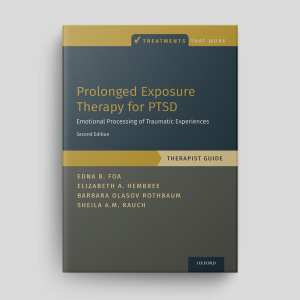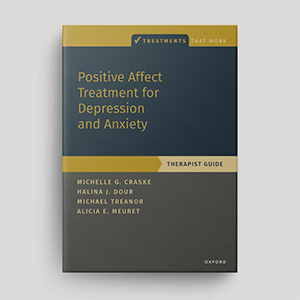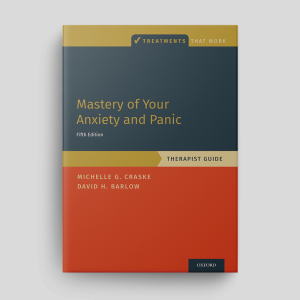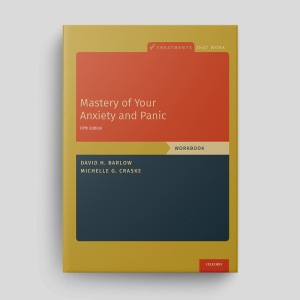Reclaiming Your Life From A Traumatic Experience (Second Edition): Workbook
Reclaiming Your Life From A Traumatic Experience is a structured workbook for people undergoing prolonged exposure (PE) therapy for post-traumatic stress disorder (PTSD). This program consists of 8-15 weekly or twice-weekly sessions and the workbook provides psychoeducation, worksheets, and exercises designed to support clients through the process. A therapist guide is downloadable separately.
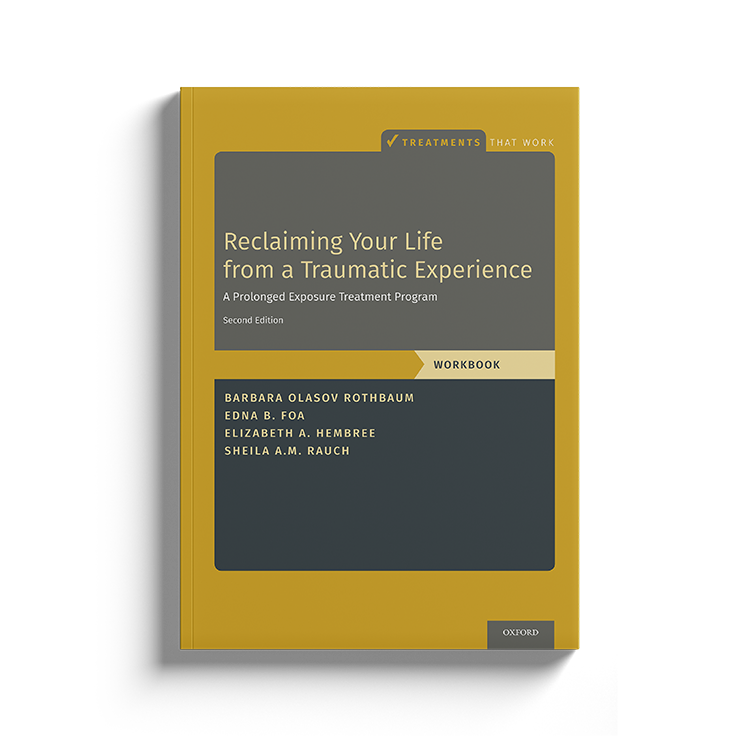
Download or send
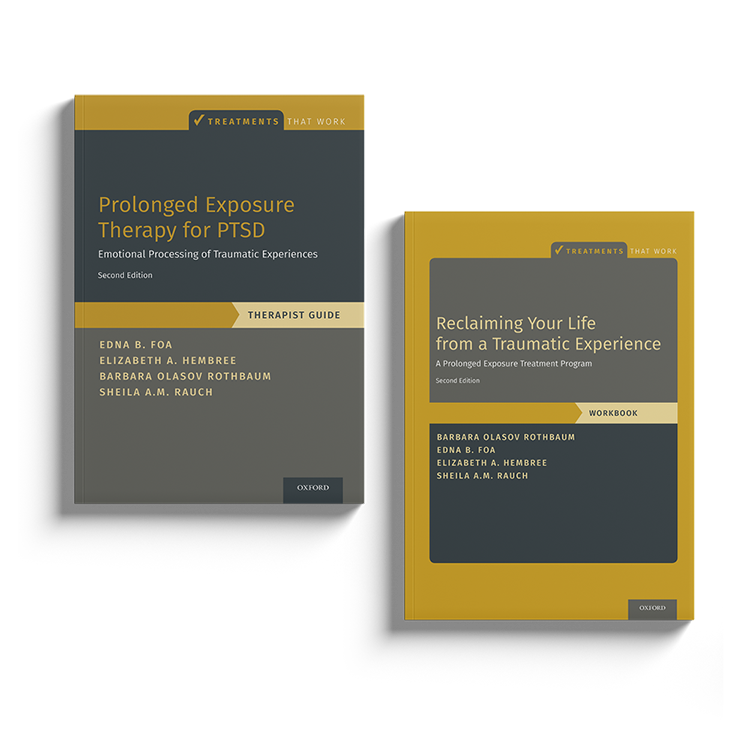
Overview
Prolonged exposure (PE) is a first-line treatment for post-traumatic stress disorder (PTSD), recommended by the American Psychiatric Association (APA) and the UK National Institute for Health and Care Excellence (NICE). Reclaiming Your Life From A Traumatic Experience: Workbook (Second Edition) is written by Edna Foa, Elizabeth Hembree, Barbara Rothbaum and Sheila Rauch and provides therapists with all the tools they need to deliver effective, evidence-based psychological treatment for PTSD. Part of the Treatments That Work™ series, it provides therapists with a background to the foundations of prolonged exposure as well as step-by-step instructions for guiding clients through key interventions and teaching them the skills they need to overcome PTSD.
Why use this resource?
Prolonged exposure (PE) therapy is a well-researched and highly effective treatment for PTSD. By repeatedly confronting feared memories and situations, clients learn that these experiences, while distressing, are not inherently dangerous.
- Encourages systematic exposure to trauma-related stimuli.
- Helps clients gain mastery over avoidance behaviors.
- Reduces PTSD symptoms, including intrusive memories and hyperarousal.
- Supports gradual emotional processing and cognitive restructuring.
- Includes practical exercises and worksheets to enhance the effectiveness of therapy.
Key benefits
Guidance
Psychoeducation
Processing
Support
What difficulties is this for?
Post-Traumatic Stress Disorder (PTSD)
Persistent distress following a traumatic event.
Combat-Related PTSD
Trauma symptoms in military veterans and service members.
Sexual Assault Survivors
Processing distress related to sexual violence.
Natural Disaster Survivors
Trauma-related symptoms following earthquakes, hurricanes, or floods.
Serious Accidents
PTSD resulting from car crashes, workplace injuries, or medical trauma.
Complex Post-Traumatic Stress Disorder (CPTSD)
Trauma from prolonged or repeated abuse, including childhood trauma.
Integrating it into your practice
Assessment
Evaluate PTSD severity and suitability for prolonged exposure therapy.
Psychoeducation
Introduce clients to PTSD and the role of avoidance.
Exposure Planning
Create a hierarchy of feared situations for exposure.
Prolonged Exposure
Guide clients in revisiting and processing traumatic memories.
Self-Monitoring
Use worksheets to track distress levels and progress.
Cognitive Processing
Explore and update maladaptive beliefs related to the trauma.
Relapse Prevention
Equip clients with strategies for maintaining gains.
Theoretical background and therapist guidance
Traumatic events occur frequently, with up to 60% of the US population exposed to at least one traumatic event in their lifetime (Kessler et al, 1995). The National Comorbidity Survey (2005) found lifetime rates of PTSD in the general US population of 3.6% for men and 9.7% for women.
Prolonged exposure (PE) emerged from the adaptation and extension of emotional processing theory (EPT) to PTSD. The overall aim of the treatment is to help trauma survivors to emotionally process their traumatic experiences to diminish or eliminate PTSD and other trauma-related symptoms. PE has been tested in hundreds of efficacy studies which have demonstrated that PE is highly effective at ameliorating the symptoms of PTSD, depression, anxiety, guilt, and suicidal behavior.
Prolonged Exposure Therapy For PTSD is a comprehensive program to assist clinicians in delivering effective PE for PTSD. The program includes two books:
- Prolonged Exposure Therapy For PTSD: Therapist Guide is the companion to this workbook. It details the step-by-step treatment of PTSD using PE.
- Reclaiming Your Life From A Traumatic Experience: Workbook will help your patients to become active participants in their treatment and to learn to manage panic attacks, anxiety about panic, and avoidance of panic and agoraphobic situations.
Authored by leading psychologists including David Barlow, Michelle Craske and Edna Foa, Treatments That Work™ is a series of manuals and workbooks based on the principles of cognitive behavioral therapy (CBT). Each pair of books – therapist guide and client workbook – contains step by step procedures for delivering evidence-based psychological interventions and will help you to provide the best possible care for your clients.
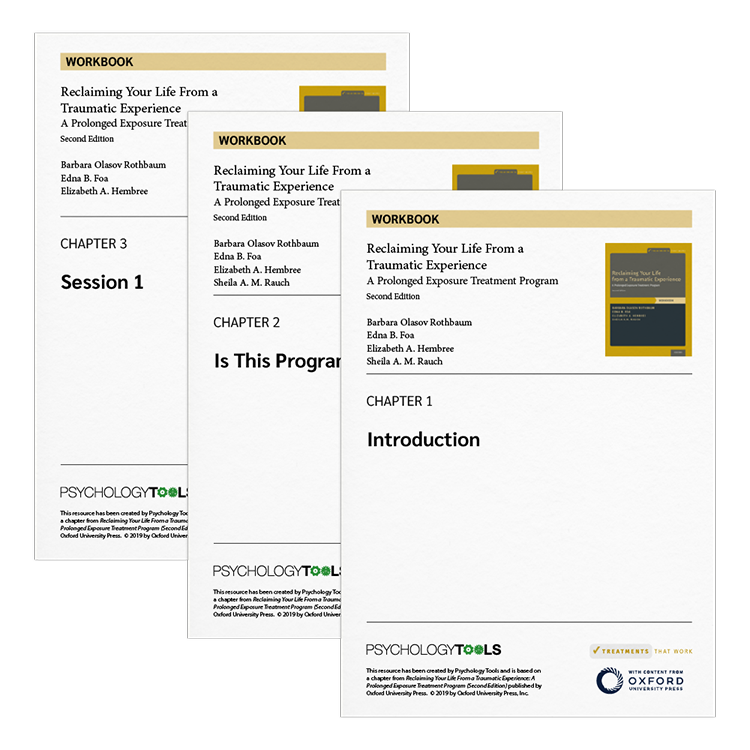
What's inside
- Psychoeducational materials on PTSD and avoidance behaviors.
- Structured exposure hierarchy worksheets.
- Step-by-step instructions for conducting imaginal exposure.
- Exposure tracking tools
- Strategies for managing distress and maintaining treatment gains.
FAQs
How this resource helps improve clinical outcomes
By integrating prolonged exposure therapy principles into treatment, this treatment program supports:
- Reduction in avoidance behaviors and trauma-related distress.
- Increased emotional processing.
- Improved client engagement in therapy exercises.
- Structured tracking of therapy progress and symptom reduction.
Clinicians benefit from:
- A clear framework for implementing exposure exercises.
- Client-friendly worksheets that reinforce therapy goals.
- A comprehensive tool for guiding PTSD treatment.
Clinicians who use this resource also use
References and further reading
- Cusack, K., Jonas, D. E., Forneris, C. A., Wines, C., Sonis, J., Middleton, J. C., ... Gaynes, B. N. (2016). Psychological treatments for adults with posttraumatic stress disorder: A systematic review and meta-analysis. Clinical Psychology Review, 43, 128–141.
- Kessler, R. C., Sonnega, A., Bromet, E., Hughes, M., & Nelson, C. B. (1995). Posttraumatic stress disorder in the National Comorbidity Survey. Archives of General Psychiatry, 52, 1048–1060.
- Lee, D. J., Schnitzlein, C. W., Wolf, J. P., Vythilingam, M., Rasmusson, A. M., & Hoge, C. W. (2016). Psychotherapy versus pharmacotherapy for posttraumatic stress disorder: Systematic review and meta-analysis to determine first-line treatments. Depression and Anxiety, 33(9), 792–806.
- Resick, P. A., Pallavi, N., Weaver, T. L., Astin, M. C., & Feuer, C. A. (2002). A comparison of cognitive-processing therapy with prolonged exposure and a waiting condition for the treatment of chronic posttraumatic stress disorder in female rape victims. Journal of Consulting and Clinical Psychology, 70, 867–879.
- Rothbaum, B. O., Astin, M. C., & Marsteller, F. (2005). Prolonged exposure versus eye movement desensitization and reprocessing (EMDR) for PTSD rape victims. Journal of Traumatic Stress, 18, 607–616.
- Watts, B. V., Schnurr, P. P., Mayo, L., Young-Xu, Y., Weeks, W. B., & Friedman, M. J. (2013). Meta-analysis of the efficacy of treatments for posttraumatic stress disorder. Journal of Clinical Psychiatry, 74(6), e551–e557.
Just enter your name and email address, and we'll send you Reclaiming Your Life From A Traumatic Experience (Second Edition): Workbook (English US) straight to your inbox. You'll also receive occasional product update emails wth evidence-based tools, clinical resources, and the latest psychological research.
Product
Company
Support
- © 2026 Psychology Tools. All rights reserved
- Terms & Conditions
- Privacy Policy
- Cookies Policy
- Disclaimer
Working...
We value your privacy
This site uses strictly necessary cookies to function. We do not use cookies for analytics, marketing, or tracking purposes. By clicking “OK”, you agree to the use of these essential cookies. Read our Cookie Policy
